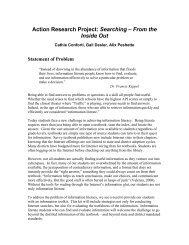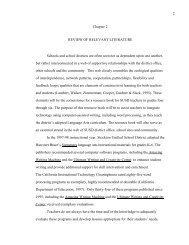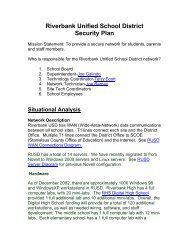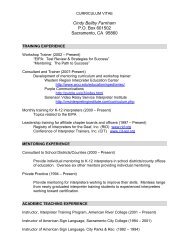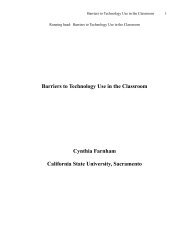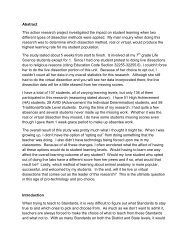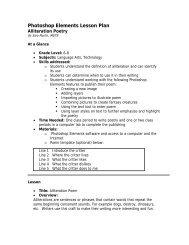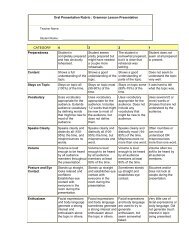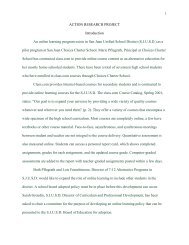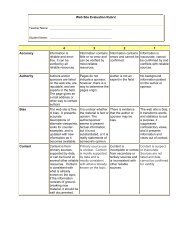Action Research - iMET
Action Research - iMET
Action Research - iMET
Create successful ePaper yourself
Turn your PDF publications into a flip-book with our unique Google optimized e-Paper software.
Devising New Mediums for Group WorkI find typing on the keyboard of a computer is easy as picking up a dry erasermarker. To many, this might sound an absurd simile, but if you note the change fromchalk to dry eraser marker, it is very possible. The way we communicate is everchanging. The land-lined telephones no longer possess the power of my parents’generation; instead cell phones, instant messengers, e-mails have overridden theirpopularity. Students in my class have moved as easily from one item to another. Let meexplain: one day, as I was facilitating group work, I noticed how students no longer wrotedown their telephone number as their form of contact; instead, they wrote down sillynames, some with numbers others without numbers. I thought they were goofing off, andasked, “Why aren’t you organizing your group?” Then a student explained the nameswere their Instant Messenger names. Luckily, I didn’t need to ask for clarificationbecause I knew what they meant by Instant Messenger names. After carefullynoting this, I wandered around the classroom asking different groups if they too employinstant messengers as a means of communication for their group work. Many replied witha ‘yes’. The following questions then came to mind:1. How will I know if all students are working to complete an assignment?2. What can I do to shorten the amount of class time used for group assignments?3. How can I use their already existing knowledge about Instant Messengers andChat Rooms to my instructional advantage?So I then began to design a series of more informal and in depth questions aboutstudents’ use of Instant Messengers and Chat Rooms, created an action plan, requestedvolunteers, acquired necessary signatures and then implemented the following study.
offline. Yet in order to ensure students did not get too frustrated from working withdifferent modes of outside communication, I emphasized the need for studentsvolunteering for the study to work with one another. Students who did not want toparticipate in the study were not required to work in separate groups butknew it was encouraged. They were then asked to exchange telephone numbers andInstant Messenger names. For many this was very easy because they used the sameInstant Messenger programs, American Online Instant Messenger (AIM), MicrosoftScreen Names (MSN) or Yahoo! Instant Messenger programs. For others it was moredifficult because they realized that their Instant Messenger were not compatible with theirgroup members’.At that point, I stepped back and watched their interaction. I observed studentshelping one another explain how to sign up for the IM programs and how to differentiateamong the IM programs and their compatibility. This was great because as the personbehind the great project idea, I was clueless to the fact that Instant Messenger programsdiffered. I went home to do a little more research and found out some fascinating thingsabout the various Instant Messenger programs. AIM owned and operated by AmericanOnline allows any Internet user to download the program for free, which means that youdo not have to be a member of the Internet carrier. The program has a buddy list windowthat allows the user to know when another friend or relative is online. It enables Internetusers to communicate via private, personalized text messages. MSN and Yahoo! InstantMessenger programs have similar features but give different names for the buddy list.Basically, the programs are only compatible with same carrier. An MSN InstantMessenger will not be able to find an AIM user. They can only locate Internet users with
individual accountability: “Team rewards and individual accountability are essential forbasic skills achievement. It is not enough to simply tell students to work together; theymust have a reason to take one another’s achievement seriously” (p.3). So for the nextonline assignment, students were told that the leader of the group had twenty points togive to individual group members. If the leader decides a member earned his or her pointthen that was that. Of course, there were oppositions to this new method.“Well what if he gets mad at me,” said one student.“That’s not fair, she can give full credit to her friends,” said another student.I explained to the disgruntled students that they were forgetting an essentialcomponent of this assignment; one of the requirements is that they needed to sendtranscripts of their Chat Room sessions to me. So if discrepancies arose, I would be ableto go back to the transcripts and judge what happened, and who earned what. Thisseemed to appease many of them. I then faced the problem with groups who were notusing online Chat Rooms as their mode of communication. I told them the same thing,but instead of transcripts I would listen to individual members and judge from there.Another situation had arisen, where one group member did not send the transcriptbecause she had logged off prior to saving it. An additional responsibility was given tothe Back-Up person; he or she needed to keep a back up of the transcript(s).After noting all the frustrations, we discussed what they learned about the topicsassigned. Students who were in the same group expunged similar information. They alsoexplained how the online format helped them because they were able to search the Netfor more information on the subjects. They were able to get information and site
addresses quickly to one another. Students then spent the next week drafting and revisingtheir final paper in class. So group work was no longer needed.During that time when I reflected back, I thought it was a horrible idea to start thestudy at the end of one unit and continue it on to the next unit because I thought I wouldlose the momentum. I also thought I would find difficulty with the change in topics.However, this was not the case. After fine tuning some of the challenges from the firstassignment, I went over roles and responsibilities again; and noting that this time aroundleaders had the power of points, back-up student had to save a copy of the transcripts andI gave more time for groups to get together. And these changes were clearly outlined onan assignment sheet with step- by- step instructions of what the group needed tocomplete.Students were given three class days to access and read “History of Night” byJorge Luis Borges online. Students without online access could print it from the librarycomputers. They were still required to work in their assigned groups to complete theassignment. They needed to read the poem, discuss words and phrases they did notunderstand, discuss the poems literal meaning, find poetic devices, explain how poeticdevices help further poem’s understanding, discuss the deeper meaning of the poem andcreate a summary outlining the following: theme, recurring motif, imagery,characteristics of Latin American poetry and poetic devices. While groups individuallyworked outside on “History of Night” I modeled the steps with the whole class with“Poetry” by Jorge Luis.The second time around was the charm because there was less confusion aboutwhat to do and less complaints. However, one student, the same one who was upset about
controlling his group wanted the study to be over. He no longer enjoyed using InstantMessenger to do his work because he was tired of watching out for his spelling, his wordchoices and getting his members online at the same time. He explained that prior to thestudy when he used Instant Messenger it was to ask for help from whoever was online atthe time. He didn’t need to synchronize his watch to his friend’s. Most of all, he wasscared that I knew when he was online. I told him his reasons were valid and that all theyneeded to do for me now was go online one more time to discuss with group memberswhat they found useful about using Instant Messengers and Chat Rooms to completegroup projects and that this assignment would be extra credit. I also asked two groups todiscuss face to face the pros and cons of using Instant Messengers and Chat Rooms.Although there were only two official group assignments given utilizing InstantMessengers and Chat Rooms, the data collected illustrates many interestingcharacteristics of group interactions, student motivation and subject matter attainment.Presentation of DataBoth qualitative and quantitative data collection was used; but the majority of the datagathered were qualitative in nature.1. Surveys—Students filled a survey prior to participating in the actual process ofcompleting group work via Instant Messengers and Chat rooms.2. Interviews—Interviews were given both prior and after the process to groups thatvolunteered. Two groups were taped when interviewed. During face to faceinterviews, I prompted students to elaborate and clarify. The taped interview wasmanaged by the separate groups.
3. Matrix— All the e-mails, Instant Messenger and Chat room discussion transcriptswere printed and analyzed4. Artifacts— Students turned in assignments along with reflection on group workperformed.FindingsWhile I was sorting through the data and categorizing them into their segmentedparts, the following themes and sub-themes surfaced.Pros and cons of using instant messenger and chat rooms as learning environments.Students were divided in their reactions. In their final interview both online andduring a video taped interview, students found that there were both pros and cons to usingChat Rooms and Instant Messenger as tools to complete group projects.The positive reactions to using instant messaging and chat rooms in completingassignments included the following reasons:1. Distance is not a factor2. Easy access to Online resource3. Warning controls keep others from using foul languageWhile, the negative factors included:1. Conflict in scheduling synchronized meetings.2. Difficulty in keeping everyone on task3. Unaware of where everyone is Online4. Inability to decipher tone of classmates5. No adult authority figure present6. Computers are not accessible to all students
Ease and convenience of using instant messaging and chat rooms for bothteachers and students.Instant Messaging and Chat Room are convenient and easy to use. It provides userwith real-time, immediate response. In a student survey and a series of interviewconducted in April 2004, 23 students had the following to say about the advantages ofInstant Messaging and Chat rooms in relation to ease and convenience over the telephoneand face to face meetings:1. 17 out of 23 students think using IM and Chat Room is easier than talkingover the telephone2. Relaxed atmosphere; no one to tell you to watch your language3. Free with Internet connection4. No one location is necessary besides the WEB5. 19 out of 23 students found it more convenient to meet on the WEB than inperson6. Online access to multiple resources7. Multiple conversations can take place with enmityAs online tools, Instant Messengers and Chat Rooms avail students to an infinite sourceof information. Students are able to access Webster.com if they need to clarify a word’smeaning; they are able to send parts of an assignment whether it be typed or cut andpasted in seconds to their group members; and they can even read literature on the workstudied or topic assigned in order to pursue further in depth understanding. All of thesebenefits were used in one form or another by the students and their group members as canbe seen in the following example:
1JBNelly429: I’m not finding the poem…3nellybell016: ok scroll down to where it says poems by borges3nellybell016: and it’s the third one3nellybell016: did you find it4mxconvi45: hmmmmmmm……4mxconvi45: deep1JBNelly429: no..ok, the title on the top of the page I have is called ItaloCalvino…???4mxconvi45: ….1JBNelly429: i typed in the link from the paper, I probably messed it up4mxconvi45: http://www.sccs.swarthmore.edu/users/00/pwillen1/lit/index3.htm4mxconvi45: did that work1JBNelly429: let me see1JBNelly429: yeah, ok, I’m reading it nowNotice how 3nellybell06 tried to explain where the poem was located on the actualWebsite, but 1JBNelly429 wasn’t even on the correct Website. 1JBNelly429 thinks she’sbeen typing in the correct site but can’t seem to get it right until 4mxconvi45 types in theaddress for her and 1JBNelly429 links to it from the address given by 4mxconvi45. Thisis definitely something students cannot do over the phone. Another example of howstudents can help one another to retrieve information can be seen in the followinginteraction:xWindir999: should I go into WHY people most likely resorted to racism andwhat-not?
xWindir999: not surexWindir999: i dont think that they werexWindir999: 8v7 1nn |\|07 5v|z3xWindir999: ERICA2hotirishgurl16: yes yes???xWindir999: Brainstorm3NewGreenPark182:(Link:http://www.chipublib.org/0033cpl/onebook/trials.html)http://chipublib.org/003cpl/onebook/trials.htmlxWindir999: G UT3NewGreenPark182: scottsboro is a small town by the way, i just looked it up.xWindir999: ok good3NewGreenPark182: i think that is the one she had us look at in classAgain, in order to get access to information a member of the group provided a link to aresource site. However accessibility to information and ease of tool is only one beneficialcorrelation.Lack of face-to face meetings and voice recognition effect student interaction.Student interviews and reflections suggested the lack of face to face and voicerecognition affected the way they communicated with one another. They could notunderstand the intonation behind words, or any emotional connotations thereof. However,transcripts of their discussions reveal alternative methods were used to replace the lack ofaudio and visual components of communication. Students changed language to replacethe components regularly observable during face-to-face communication. In place of
visual cues, students used (a) smiley or sad faces, (b) color, and (c) size differentiation. Inplace of voice recognition or intonation, students (a) refused to type; (b) used bold colorscoupled with larger or small fonts; and/or (c) used excessive punctuation.Instant Messaging programs allow students to do communicate as they wishwithout being reprimanded for incorrect usage of the English language. Twenty out oftwenty-three students said they did not use proper grammar when they communicatedonline. This can be seen especially in their language usage. Words, phrases, but rarelycomplete sentences were used. They were represented by colors, different sizes and fontstyles, which clearly reveals a form of play with words; thus allowing students to expressthemselves as they wished without minding grammar or spelling. The abrupt, shortenwords were acceptable and work off of their prior knowledge. Perhaps, this is why thisinterplay of words was comprehensible to all group members. However, once and awhilethe so called taboo words would appear in writing; but, as quickly as it appears in type, itdisappears. As seen in the following example:timeout what is the recorder supposed to doidkmake the final product so troy u don’t have to make itits mikes jobokwheres chris?I think ian might be rite8:05 PMi know im right biatch
u can lave that line ou whan u printwhen*hell naw uh i think i’m supposed to write what how we are progressingfineits still ur job then troyian i dont think I can edit things outwe got 2 mins leftr u seriousso what let ms kuy read this shiatyup its benn like 40 minsThis excerpt was difficult to figure out who was saying what because the transcript thegroup sent did not have the Instant Messenger names. However, the color coordinationand font style could be linked to the individual members. Note how taboo words orswears popped up and the student who wrote it wanted it erased from the transcript, butanother member wanted to keep it so as to note how the group members were gettingalong. They shorten words such as “are” to “r” and “you” to “u”. And at times, found theneed to correct spelling. The student with aqua blue Comic Sans writing wanted hisgroup members to see “whan” is really supposed to be “when”.Tools as a motivator.
Students have a vested interest in the topics when the topics are taught in a waythat motivates them or catapults their already existing interest (Sternberg & Zhang, 2001)Out of 23 students surveyed, 22 already had an instant messenger program. Nineteen ofthem used it more than twice a week and 11 used it more than five times a week.A claim can be made that because 22 out of the 23 students already had access to the tooland that 19 out of 23 used it more than twice a week that there exists an interest inutilizing the tool as a means of communication. In addition, all the students whoparticipated showed great enthusiasm for the study because they immediately broughtback permission slips the following day. Comments made during student reflection alsosuggest that they would be willing to use Instant Messenger and Chat Rooms for futureassignments. As stated by xWindir999: “I think online collaboration should beincorporated into school curriculum for those of us with internet”. And he continues toexplain his reasoning: “online, when a group is collaborating, anyone within the grouphas instant access to information (Internet) and the ability to share his/her findings (viahyperlink). xWindir999’s comment suggests that a possible motivator for students towork online is a result of their ability to access information immediately.Cooperative learning and individual accountability: studying tone & mood of studentsonline transcripts.When students were given clear individual accountability they were able to workeffectively together in an online environment. The Tools of Instant Messaging and ChatRooms provided students with a learning environment that allowed them to access andshare information with one another. First it allowed students the ability to be
understood by all members. The fear of face to face interaction was eliminated. Studentswere empowered to use their own language system. Then when all students wereaccountable, students proved that they could work well with one another to help allwilling members achieve the desired goals.The first assignment given to students did not have any accountability forindividual students. Yes, they were given assigned roles, but when the leaders were giventhe power of points many of the group members began to contribute more and were moreon task. The group interaction between the second example that was provided undercan be indicative of how students did not utilize their time wisely because they lackedclear direction and accountability.U know what screw u guys make me do all the work are u guys inanother chat telling each other and voting on who should do whatim not of course u probably wont believe mewow cool this freakin online group project is a waste of timeuh you thinkyeah reallyhey ms kuyquote me on thisonline projects in chat room are a waste of time as our group has displayedAnd it continues at the very end of the transcript where students did not have anythingcompleted. However after making the individual members accountable note the change insecond assignment with student behavior:were gonna start at 7:30 whether or not mike and chris show up
7:25 PMboth of u read the poemnow ritkmore paoints for ustheir fault they didn’t show upyeahso what theme or reoccurring motif was thereit has to do with day and night….i thinkAfter bantering in the beginning for five minutes students directly began work. Therewere no arguments about who is supposed to do what. Instead they read the poem, andstarted to following the assigned steps. Further in the course of their discussion, theybegan to help one another clarify points and allowed everyone to have a say.is “she” night in the poemHistory of the Nightyes?Oki don’t know, I interpret it more as being day and nighti not really sure it kinda confused meor contrasting the struggles you go through in the darkness and the light slowlygrowing into day and the pain of darkness fading away…that sound good to melol
yahlets wait to see what ian has to say though7:30 PMThe leader helped direct the members to a possible interpretation but allowed theindividual members to give their opinion before anything is concluded. The drasticchange in the mood and tone of the group and the way they interacted with one anothercan be attributed to what Slavin (1990) calls individual accountability. “The reason forthe importance of group goals and individual accountability is that there must be someincentive for students to help one another learn” (Slavin, 1990, p. 31). In addition,students were able to work well with one another in an Online environment.Another example of group dynamics where there was a drastic shift in both thetone and mood of the group. For the first assignment when the leader didn’t reallyunderstand his/her role and there was no individual accountability involved groupmembers were moody, rude and unproductive. The following transcript excerpt takesplace after 12 minutes of being online in a Chat Room.vBballgurl2433: what do we need to dovBballgurl2433: i am duh im typing arnt ifRoxychick4557: and find diffs and right them downsSmiliemonkeychic: okay reanna what do we need to do exactlyvBballgurl2433: what the hjella whya re you getting mad at me3SMILEY22Sml5: ya’ll stop itfRoxychick4557: lol im, not sorryfRoxychick4557: okay this is what u guys do
There is a lot of bantering and unproductivity for the next several interactions. By the endof the transcript they were ready to get out of the Chat Room because they could notfigure out how to work with one another. After the leader was given the points todistribute to each member, all the members made sure they were present and working.One of the group members was on the phone with another member that helped explainwhat was happening in the Chat Room. Their tone and mood drastically changed. Andthey begin to employ cooperative learning methods where one member helps anotherclarify and explain a given concept. Students began to focus on their task as eachindividual member had a clearer understanding of their roles.2randomMLchic: I don’t understand it that much but then agai ihavent sunk it intomy head because im really out of it right now but im trying to stay focuesedfRoxychick4557: okay2randomMLchick: umm like in the beginningfRoxychick4557: well let me explain2randomMLchic: Olivia is confused also2randomMLchic: in the beginning..the poem is informing that people have madenight different feelings like okay how you go out at night because theres weirdosout there and stuff because scarey movies are based on night time, the boogie manand all that stuff2randomMLchic: oo okay I get it and so does Olivia now2randomMlchic does not understand the beginning of the poem and neither did her groupmember on the phone. However, the group’s leader known by her SN as
froxychick4557 explains it to her members by giving a conceptual analogy that her othermembers might comprehend. This group interaction is illustrated in all the transcripts.3sk8hotti11: but do u understand the poem at all becuz i don’t2chrisgen87: well I don’t get the hole thing i do get litl parts6sk8hotti11: yea me tooo what parts do u get?2chrisgen87: like how the author personifies the night as a woman6sk8hotti11: den we can see if we can piece together wat each of us get6sk8hotti11: yea dats good2chrisgen87: well lets build ourselves a puzzle6sk8hotti11: kThey first explained what they knew individually, capitalizing on their strengths andfurther in the transcript they discuss the things they did not understand and wrotequestions down for class.ConclusionThe study provided a better understanding about what students do when they arecharged with completing group work via instant messenger and chat rooms. Onlinemeetings, using instant messenger and chat rooms, did not allow students to simply playwith the tools. The use of Instant Messenger and Chat Rooms as medium ofcommunication among students provided a lasting record of their discussions. It is notfleeting like a conversation that can be missed if the teacher is not present. It can provideeducators with the means to studying group interaction, and individual student’s ability tograsp a given subject matter. Students’ discussion outside of class provided preparation
for class discussions. They are able to sift through their questions and answer those thatare clear to group while formulating the questions that need to be asked in class.Students were able to have active discussions amongst their group members. It providedthe opportunity for students to discuss and clarify topic(s) of a given assignment amongstgroup members prior to class discussion. The meetings provided students time to thinkand formulate questions about topics, which prepared them for class discussions. Thisproved beneficial because students did not need to use class time to think about what theywanted to ask, nor did they fear asking questions. Questions had already been discussedduring the online meetings. Students therefore, did not have to wonder if they were theonly ones with the question(s). Online meetings also provided a flexible learning patternfor students, allowing group members to work at their own pace. Transcripts from thegroup interaction revealed that students when given clear instruction and expectationshave the ability to complete projects in a timely manner. Students were able to help oneanother explain, clarify and support objectives. Many students found it convenientbecause they didn’t need to be anywhere but in their own room. The online environmentalso allowed students who normally do not voice their opinions in a typical classroom todo so. But even with its possibilities, instant messenger and chat rooms lacked face- tofacecontact, which created problems for students who did not understand what othermembers were doing or saying. Students found that being on the Internet was both goodand bad because they were able to access information readily but the same access createdoff task behavior.
However, Instant messenger and Chat rooms allowed students to cooperativelywork together in achieving both their group and individual goals. When utilized correctlywith clear direction and roles, students can work together in obtaining a goal withoutteacher supervision. However, the downside to mitigating responsibilities and givingstudents deadlines is the underlying fact that students who enjoyed the freedom to use IMand Chat as tools to socialize with friends and families, no longer saw it as such.This creates a dilemma for educators who wish to use mediums, which alreadycaptivate student interest. In wanting to use mediums such as Instant Messenger and ChatRoom tools in delivering instruction, educators risk the possibility of drawing students'interest away from the tool. Educators must therefore judge if the tools educationalbenefits outweigh the possibility of detracting student interest.ReflectionThe role of the educator is multifaceted. Educators are coaches, teachers andmentors. They work to implement new strategies that both captivate and benefit studentlearning. Problematic conditions and situations will arise through this process. With theimplementation of education technology, new tools are always surfacing and thestrategies of using them in the classroom changes.The <strong>Action</strong> <strong>Research</strong> illustrated numerous possibilities of how to use online tools,instant messenger and chat rooms as a form of instruction. The process, however, provedexhausting at times because even with cooperative learning in place, the teacher mustinitially check up on students during online sessions. The initial facilitation of checkingfor understanding created some new responsibilities and expectations for both the teacherand students. Students who normally found using online tools as a method of social
interaction were being asked to use them for educational purposes. When the toolsbecame a requirement, some students voiced their reservations. They knew I had a buddylist of their screen names. As soon as I logged onto the computer my buddy listautomatically appeared, telling me who was online. In addition, it allowed students to beaware of my presence online. There were times, when I was online for my own purpose.Students still instant messaged me about schoolwork that had nothing to do with thestudy I was conducting. Some students used instant messaging to socialize with me. I wasunsure about discussing personal matters with students. In the back of my mind Iremembered there needed to be a boundary between the student-teacher relationships.The extent to which teachers must invest personal hours as part of their regulareducational hours proved to be a drawback for the research. Students too felt as if theirpersonal space was being encroached upon. There was also the problematic situation ofhelping a group of students more than others. Students who were online, while I wasonline were able to receive instant feedback and clarification from me. I began tounderstand that the role of the teacher must be more flexible in an online environmentthan that of the school environment because there are more aspects that are not present inregular classrooms..
ReferencesSlavin, R. (1990). Cooperative learning: theory, research, and practice. Englewood, NJ:Prentice Hall.Sternberg, R. & Zhang, L (Ed.). ( 2001). Perspectives on thinking, learning, and cognitivestyles. Mahwah, NJ: Lawrence Erlbaum Associates.AppendixesTable 1232015131051Multiple361 N/AMSNAIMTypes of Instant Messengersused by studentsTable 2Students surveyed 23
Section I: Usage and FrequencyYes No N/A1. Students with Prior Screen name 22 1 12. Want to learn how to get one 1 1 213. Use SN to communicate with friends 22 0 14. Use SN to discuss homework assignments 12 10 15. Use Multiple Windows when communicatingWith more than two person 15 7 16. Create Chat Rooms to Communicate when 6 12 5there are more than two people7. Use Chat Rooms to Discuss Homework 7 12 4assignments8. When working online, Parents think students 12 8 3Are off task9. Chat Rooms are easier mode of communication 17 5 1Than the using the telephone10. Online Chat is more convenient than 7 16 0Specific face to face location11. Use online communication more oncethan once a week? 20 2 0
12. Use online communication more thantwice a week 19 3 113. Use online communication via chat roomsor Instant Messenger more than five timesa week? 11 10 2Section II: Language and Community1. Do you feel more comfortable talkingto group members online versus face to 7 12 4face?2. Do you talk only to friends online? 9 11 33. The people you communicate with onlineabout school work, do you associatewith them outside of the online community? 22 1 04. Do you use proper grammar and spelling 2 20 1When you talk online?5. Do you know online lingo? 21 0 2Short Answers [answers varied]1. If you do have a SN, who is the host?2. Why do you use online communication?3. Do you always understand what other people are sayingeven though language usages is not grammatically correct?4. How often do you use online communication?5. Do you feel it is more efficient than working in an in class setting, at someone’shome or on the telephone? And why?





